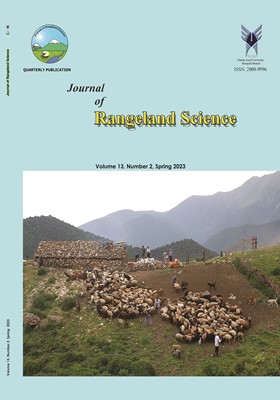Investigation of Feasibility and Effect of Alternative Farming System on the Grain Yield of Barley and Forage Production in Western Semi-arid Region of Golestan Province, Iran
محورهای موضوعی : Range ManagementArmin Arrekhi 1 , Hamid Niknahad Gharmakher 2 , Sonoko Bellingrath Kimura 3 , Johann Bachinger 4 , Ralf Bloch 5
1 - Leibniz-Zentrum
2 - Department of Rangeland Management, College of Rangeland and Watershed Managemet, Gorgan University of Agricultural Sciences Natural Resources, Gorgan, Iran
3 - Humboldt University of Berlin
4 - Leibniz Center for Agricultural Landscape Research (ZALF), Germany
5 - Professor at Department of Agroecology and Sustainable Cropping Systems at Eberswalde University of Sustainable Development
کلید واژه: barley, mixed cropping, Salsola turcomanica, Chrysopogon zizanioides,
چکیده مقاله :
One of the major challenges in semi-arid regions of Iran is to supply the adequate forage for livestock and meanwhile prevent the destruction of rangelands due to overgrazing. Therefore, this study aimed to compare three cropping systems of barley using Salsola turcomanica (ST), and Chrysopogon zizanioides (CZ) in three treatments of barley+ST, barley+ST+CZ and mono-culture of barley. Two-year field trials data were collected from November 2018 to October 2020 in two experimental sites using a Randomized Complete Block Design (RCBD) with four replications. The results of analysis of variance over two years indicated that the effects of year, location, and year by location interaction were significant (p<0.01) for all of barley’s yield components. Mixed cropping of barley with other species had no negative effect on barley traits such as grain yield, straw yield and harvest index. In addition, the mixed cropping of barley+ST and barley+ST+CZ in the first year produced 2.5 t/ha more forage yield than that mono-culture of barley. This was due to high production of Salsola (ST), in mixed cropping. In both years, yield of Salsola production was about 25% of whole produced biomass. Drastic reduction in rainfall in the second year reduced the obtained yield; so, there was no significant difference among three cropping systems in the second year. However, cropping systems of barley+ST and barley+ST+CZ produced about 1 t/ha more forage than that for the mono-culture of barley. Mixed cropping of barley +ST+CZ did not affect yield components of barley. Mixed cropping of barley with Salsola turcomanica could guarantee soil cover throughout the year and is recommended for forage production in rangeland in Iran.
Akhani, H., Trimborn, P., Ziegler, H. 1997. Photosynthetic Pathways in Chenopodiaceae from Africa, Asia and Europe with Ecological, Phytogeographical and Toxonomical Importance. Plant Systemat Evol, 206: 187-221.
Arrekhi, A., Niknahad- Gharmakher, H., Bachinger, J., Bloch, R., and Hufnagel, J. 2021. Forage Quality of Salsola turcomanica (Litv) in Semi-arid Region of Gomishan, Golestan Province, Iran. Journal of Rangeland Science, 11 (1): 74-86.
Arrekhi, A., Niknahad-Gharmakher, H, Bachinger, J., and Bloch, R. 2020. Treatments for Optimization of Salsola turcomanica (Litv) Seed Germination and Effects of Different Drought and Salinity Levels. Journal of Rangeland Science, 10 (3): 302-315.
Bakhshi-Khaniki, G.R., and Mohammadi, B. 2012. Outecology of some species of genus salsola (Chenopodiaceae) in Golestan province. Journal of Biotechnology news. 2(6): 45-52. (In Persian).
Dwyer, D.D., Wold–Yohannis, K. 1972. Germination, Emergence Water Use and Production of Russian Thistle (Salsola kali). Agron J., 64 (1): 52 – 55.
Edwards, T., Howieson, J., Nutt, B., Yates, R. O’Hara. G., Van-Wyk, B. 2019. A ley-farming system for marginal lands based upon a self-regenerating perennial pasture legume. Agronomy for Sustainable Development. 39: 13. doi.org/10.1007/s13593-019-0558-2.
Esno, H., Solna, H. and Sweden, M., 1996. Proceeding of the International Seed Testing Association. Wageningen, the Netherlands. P. 92.
Gintzburger, G., Toderich, K.N., Mardonov, B.K., Mahmudov, M.M. 2003. Rangelands of the arid and semi -arid zones in Uzbekistan. International Center for Agricultural Research in the Dry Areas (ICARDA). ISBN ICARDA 92-91 27-137-8. PP: 434.
Glenn, E., Stafford-Smith, M., Squires, V. 1998. On our failure to control desertification: implications for global change issues, and a research agenda for the future. Environmental Science & Policy 1(2): 71–78.
Hanif, Z., Haider Ali, H., Rasool, G., Tanveer, A., Singh Chauhan, B. 2018. Genus Salsola: Its Benefits, Uses, Environmental Perspectives and Future Aspects -a Review. Journal of Rangeland Science. 8 (3):315-328.
Kashki, M.T., Zandi Esfahan, E., Mohammadi, M., Ranjbar, M. 2016. Effects of growth stages on forage quality of specific halophytes (Limonium iranicum and Reaumuria fruticosa) in the Bajestan desert of Korasan province, Iran. European Online Journal of Natural and Social Sciences 5(3): 787-794.
Kenthorai-Raman, J., Alves, C.M., Gnansounou, E. 2018. A review on moringa tree and vetiver grass – Potential biorefinery feedstocks. Bioresource Technology 249: 1044–1051.
Mirzaali, M., Mesdaghi, M. and Erfanzadeh, R. 2006. The study of effects of exclosure on vegetation and soil surface in saline ranges of Gomishan, Golestan province. J. Agric. Sci. Natur. Resour., 13(2): 194-201. (In Persian).
Niknahad Gharmakher, H., Jafari Foutami, I., Sharifi, A. 2015. Effects of grazing exclusion on plant productivity and carbon sequestration (Case Study: Gomishan Rangelands, Golestan Province, Iran). Journal of Rangeland Science, 5 (2): 123-134.
Niknahad-Gharmakher H, Sheidai-Karkaj E, Jafari, I. 2017. Effects of Exclosure on soil properties in winter rangelands in Golestan province, Iran. Journal of Rangeland Science, 7(1): 55-66.
Pasandi, M., Hosseini, M.A., Kavian, A. 2017. Forage quality of important halophytes in saline and alkaline rangelands of Golestan province at two phenological stages. Iranian Journal of Range and Desert Research, 24 (3): 537-546. (In Persian).
Ranjbar, E. 2002. Role of salsola in grazing cycle of livestock in rangeland. Desert Journal, 7 (1):11-18.
Rao, A.V., Singh, K.C., Gupta, J.P. 1997. Ley farming an alternate farming system for sustainability in the Indian arid zone, Arid Land Research and Management, 11:2 (201-210), DOI: 10.1080/15324989709381472.
Shone, M.G.T. and Flood, A.N.N.V. 1988. Effect of period of localized water stress on subsequent nutrient uptake by barley root and their adaption by osmotic adjustment. New Phytologist, 94(4): 561-577.
Troung, P., Tan Van, T., and Pinners, E. 2007. Vetiver system applications. Technical references manual. www.vetiver.org. Vetiver network international.
Vadez, V., Berger, J.D., Warkentin, T. 2012. Adaptation of grain legumes to climate change. Agron. Sustain. Dev. 32:31-44.


